Critique: Building Age-Friendly Communities in Healthcare
VerifiedAdded on 2023/01/11
|7
|1670
|65
Report
AI Summary
This report provides a critique of the article "Building age-friendly communities: new approaches to challenging health and social inequalities" by Kendig & Phillipson (2014). The critique summarizes the article, highlighting its key points and objectives, including its focus on creating sustainable communities for both young and old. It identifies the intended audience and the rationale behind the article's publication, commissioned by the UK Urban ageing consortium. The report analyzes the data sources used and assesses the article's contribution to understanding the aging population, emphasizing social inequalities, environmental impacts, and the development of age-friendly cities like Manchester and New York. The critique also discusses the article's aim to address social and health inequalities and its suggestions for improving the quality of life for older people through infrastructure and community development.

Running Head: HEALTHCARE
HEALTHCARE
HEALTHCARE
Paraphrase This Document
Need a fresh take? Get an instant paraphrase of this document with our AI Paraphraser
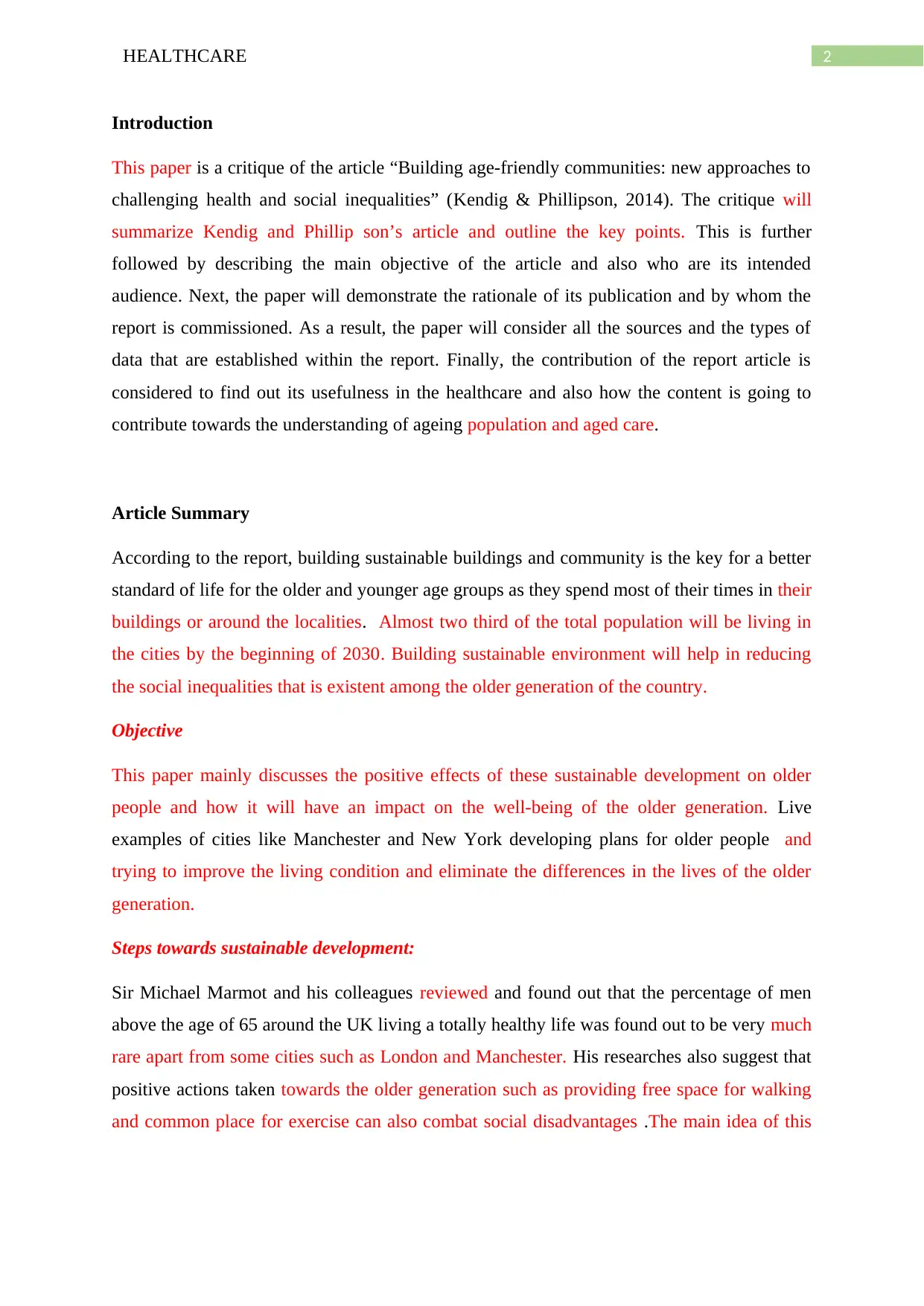
2HEALTHCARE
Introduction
This paper is a critique of the article “Building age-friendly communities: new approaches to
challenging health and social inequalities” (Kendig & Phillipson, 2014). The critique will
summarize Kendig and Phillip son’s article and outline the key points. This is further
followed by describing the main objective of the article and also who are its intended
audience. Next, the paper will demonstrate the rationale of its publication and by whom the
report is commissioned. As a result, the paper will consider all the sources and the types of
data that are established within the report. Finally, the contribution of the report article is
considered to find out its usefulness in the healthcare and also how the content is going to
contribute towards the understanding of ageing population and aged care.
Article Summary
According to the report, building sustainable buildings and community is the key for a better
standard of life for the older and younger age groups as they spend most of their times in their
buildings or around the localities. Almost two third of the total population will be living in
the cities by the beginning of 2030. Building sustainable environment will help in reducing
the social inequalities that is existent among the older generation of the country.
Objective
This paper mainly discusses the positive effects of these sustainable development on older
people and how it will have an impact on the well-being of the older generation. Live
examples of cities like Manchester and New York developing plans for older people and
trying to improve the living condition and eliminate the differences in the lives of the older
generation.
Steps towards sustainable development:
Sir Michael Marmot and his colleagues reviewed and found out that the percentage of men
above the age of 65 around the UK living a totally healthy life was found out to be very much
rare apart from some cities such as London and Manchester. His researches also suggest that
positive actions taken towards the older generation such as providing free space for walking
and common place for exercise can also combat social disadvantages .The main idea of this
Introduction
This paper is a critique of the article “Building age-friendly communities: new approaches to
challenging health and social inequalities” (Kendig & Phillipson, 2014). The critique will
summarize Kendig and Phillip son’s article and outline the key points. This is further
followed by describing the main objective of the article and also who are its intended
audience. Next, the paper will demonstrate the rationale of its publication and by whom the
report is commissioned. As a result, the paper will consider all the sources and the types of
data that are established within the report. Finally, the contribution of the report article is
considered to find out its usefulness in the healthcare and also how the content is going to
contribute towards the understanding of ageing population and aged care.
Article Summary
According to the report, building sustainable buildings and community is the key for a better
standard of life for the older and younger age groups as they spend most of their times in their
buildings or around the localities. Almost two third of the total population will be living in
the cities by the beginning of 2030. Building sustainable environment will help in reducing
the social inequalities that is existent among the older generation of the country.
Objective
This paper mainly discusses the positive effects of these sustainable development on older
people and how it will have an impact on the well-being of the older generation. Live
examples of cities like Manchester and New York developing plans for older people and
trying to improve the living condition and eliminate the differences in the lives of the older
generation.
Steps towards sustainable development:
Sir Michael Marmot and his colleagues reviewed and found out that the percentage of men
above the age of 65 around the UK living a totally healthy life was found out to be very much
rare apart from some cities such as London and Manchester. His researches also suggest that
positive actions taken towards the older generation such as providing free space for walking
and common place for exercise can also combat social disadvantages .The main idea of this
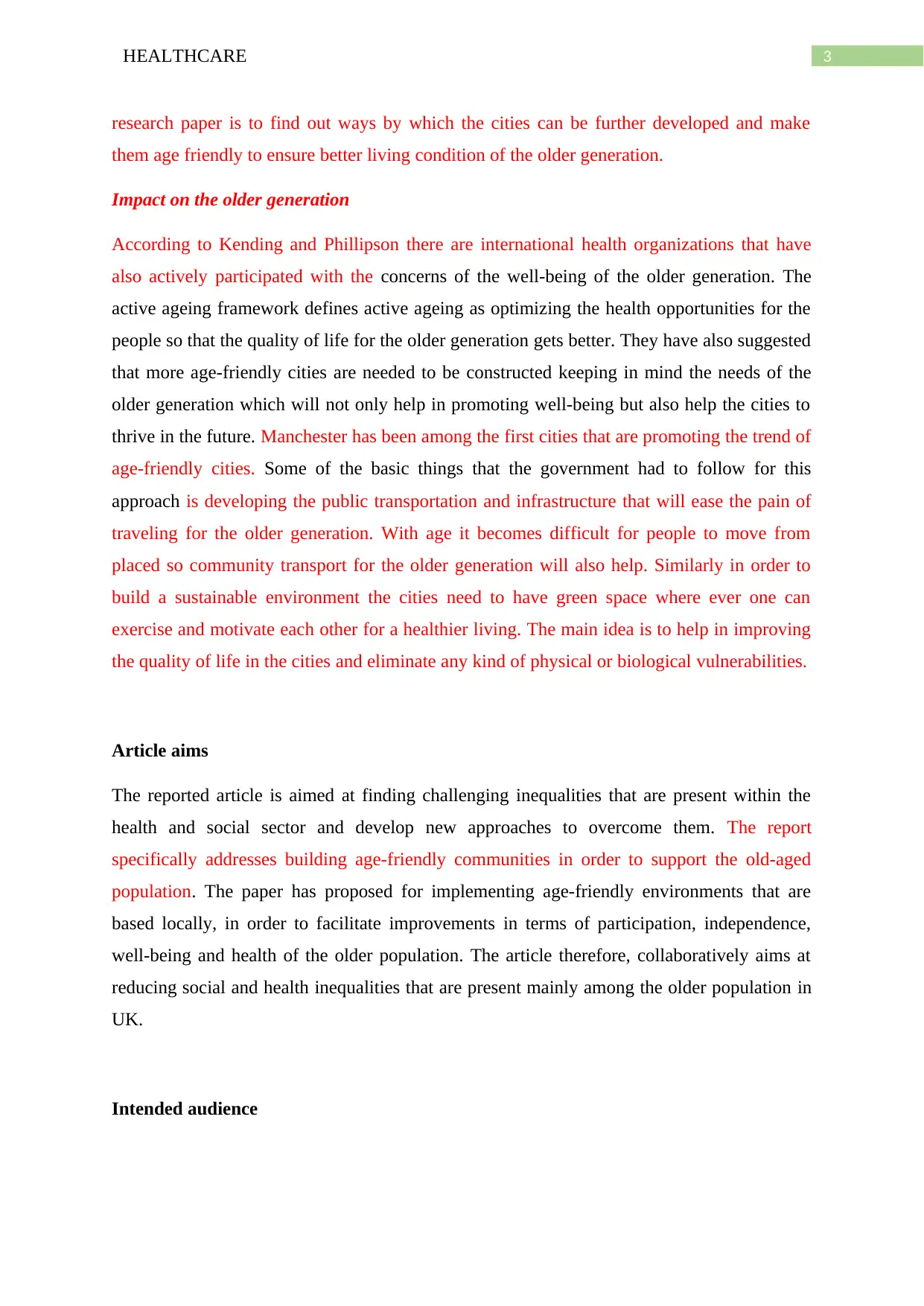
3HEALTHCARE
research paper is to find out ways by which the cities can be further developed and make
them age friendly to ensure better living condition of the older generation.
Impact on the older generation
According to Kending and Phillipson there are international health organizations that have
also actively participated with the concerns of the well-being of the older generation. The
active ageing framework defines active ageing as optimizing the health opportunities for the
people so that the quality of life for the older generation gets better. They have also suggested
that more age-friendly cities are needed to be constructed keeping in mind the needs of the
older generation which will not only help in promoting well-being but also help the cities to
thrive in the future. Manchester has been among the first cities that are promoting the trend of
age-friendly cities. Some of the basic things that the government had to follow for this
approach is developing the public transportation and infrastructure that will ease the pain of
traveling for the older generation. With age it becomes difficult for people to move from
placed so community transport for the older generation will also help. Similarly in order to
build a sustainable environment the cities need to have green space where ever one can
exercise and motivate each other for a healthier living. The main idea is to help in improving
the quality of life in the cities and eliminate any kind of physical or biological vulnerabilities.
Article aims
The reported article is aimed at finding challenging inequalities that are present within the
health and social sector and develop new approaches to overcome them. The report
specifically addresses building age-friendly communities in order to support the old-aged
population. The paper has proposed for implementing age-friendly environments that are
based locally, in order to facilitate improvements in terms of participation, independence,
well-being and health of the older population. The article therefore, collaboratively aims at
reducing social and health inequalities that are present mainly among the older population in
UK.
Intended audience
research paper is to find out ways by which the cities can be further developed and make
them age friendly to ensure better living condition of the older generation.
Impact on the older generation
According to Kending and Phillipson there are international health organizations that have
also actively participated with the concerns of the well-being of the older generation. The
active ageing framework defines active ageing as optimizing the health opportunities for the
people so that the quality of life for the older generation gets better. They have also suggested
that more age-friendly cities are needed to be constructed keeping in mind the needs of the
older generation which will not only help in promoting well-being but also help the cities to
thrive in the future. Manchester has been among the first cities that are promoting the trend of
age-friendly cities. Some of the basic things that the government had to follow for this
approach is developing the public transportation and infrastructure that will ease the pain of
traveling for the older generation. With age it becomes difficult for people to move from
placed so community transport for the older generation will also help. Similarly in order to
build a sustainable environment the cities need to have green space where ever one can
exercise and motivate each other for a healthier living. The main idea is to help in improving
the quality of life in the cities and eliminate any kind of physical or biological vulnerabilities.
Article aims
The reported article is aimed at finding challenging inequalities that are present within the
health and social sector and develop new approaches to overcome them. The report
specifically addresses building age-friendly communities in order to support the old-aged
population. The paper has proposed for implementing age-friendly environments that are
based locally, in order to facilitate improvements in terms of participation, independence,
well-being and health of the older population. The article therefore, collaboratively aims at
reducing social and health inequalities that are present mainly among the older population in
UK.
Intended audience
⊘ This is a preview!⊘
Do you want full access?
Subscribe today to unlock all pages.

Trusted by 1+ million students worldwide
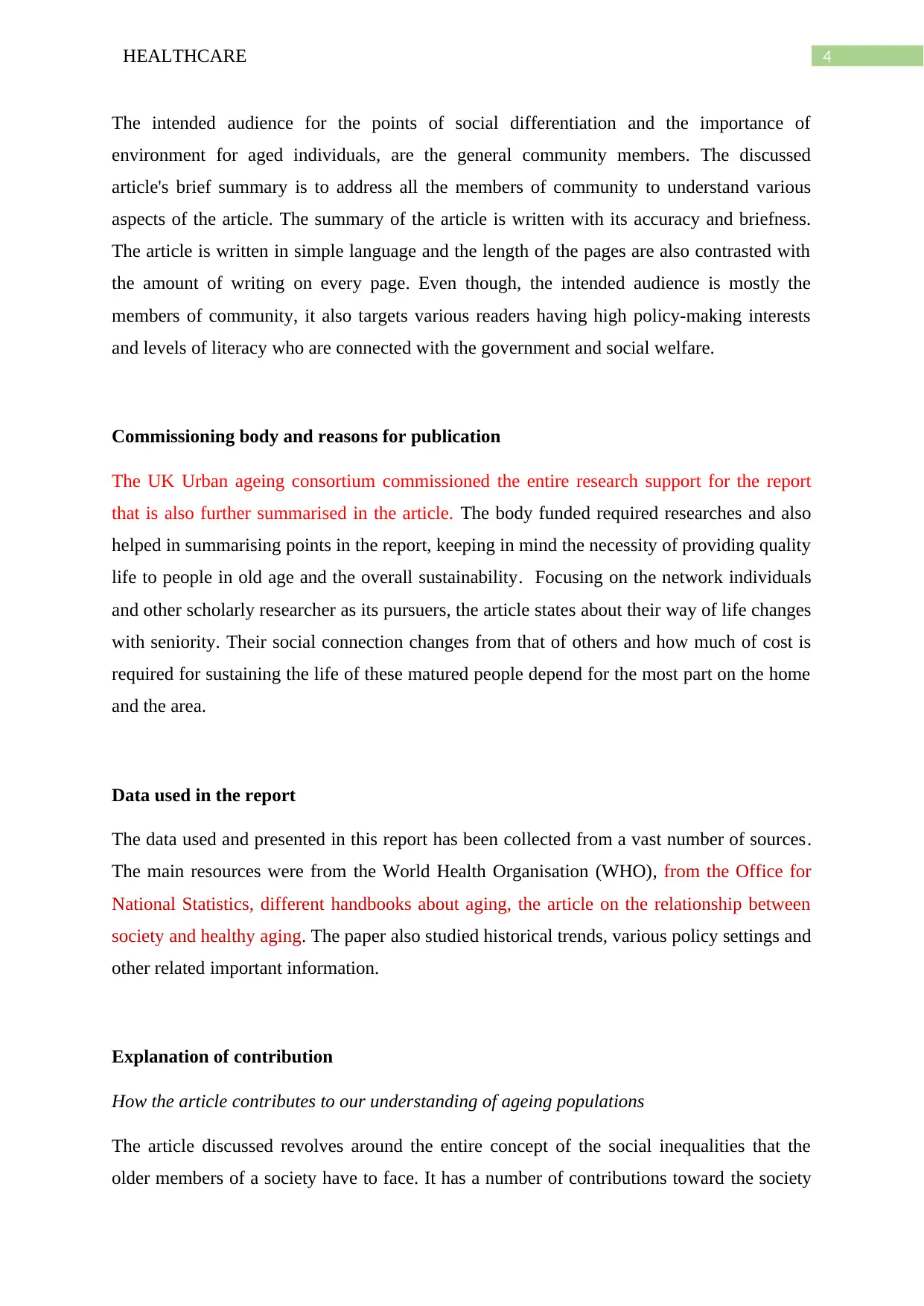
4HEALTHCARE
The intended audience for the points of social differentiation and the importance of
environment for aged individuals, are the general community members. The discussed
article's brief summary is to address all the members of community to understand various
aspects of the article. The summary of the article is written with its accuracy and briefness.
The article is written in simple language and the length of the pages are also contrasted with
the amount of writing on every page. Even though, the intended audience is mostly the
members of community, it also targets various readers having high policy-making interests
and levels of literacy who are connected with the government and social welfare.
Commissioning body and reasons for publication
The UK Urban ageing consortium commissioned the entire research support for the report
that is also further summarised in the article. The body funded required researches and also
helped in summarising points in the report, keeping in mind the necessity of providing quality
life to people in old age and the overall sustainability. Focusing on the network individuals
and other scholarly researcher as its pursuers, the article states about their way of life changes
with seniority. Their social connection changes from that of others and how much of cost is
required for sustaining the life of these matured people depend for the most part on the home
and the area.
Data used in the report
The data used and presented in this report has been collected from a vast number of sources.
The main resources were from the World Health Organisation (WHO), from the Office for
National Statistics, different handbooks about aging, the article on the relationship between
society and healthy aging. The paper also studied historical trends, various policy settings and
other related important information.
Explanation of contribution
How the article contributes to our understanding of ageing populations
The article discussed revolves around the entire concept of the social inequalities that the
older members of a society have to face. It has a number of contributions toward the society
The intended audience for the points of social differentiation and the importance of
environment for aged individuals, are the general community members. The discussed
article's brief summary is to address all the members of community to understand various
aspects of the article. The summary of the article is written with its accuracy and briefness.
The article is written in simple language and the length of the pages are also contrasted with
the amount of writing on every page. Even though, the intended audience is mostly the
members of community, it also targets various readers having high policy-making interests
and levels of literacy who are connected with the government and social welfare.
Commissioning body and reasons for publication
The UK Urban ageing consortium commissioned the entire research support for the report
that is also further summarised in the article. The body funded required researches and also
helped in summarising points in the report, keeping in mind the necessity of providing quality
life to people in old age and the overall sustainability. Focusing on the network individuals
and other scholarly researcher as its pursuers, the article states about their way of life changes
with seniority. Their social connection changes from that of others and how much of cost is
required for sustaining the life of these matured people depend for the most part on the home
and the area.
Data used in the report
The data used and presented in this report has been collected from a vast number of sources.
The main resources were from the World Health Organisation (WHO), from the Office for
National Statistics, different handbooks about aging, the article on the relationship between
society and healthy aging. The paper also studied historical trends, various policy settings and
other related important information.
Explanation of contribution
How the article contributes to our understanding of ageing populations
The article discussed revolves around the entire concept of the social inequalities that the
older members of a society have to face. It has a number of contributions toward the society
Paraphrase This Document
Need a fresh take? Get an instant paraphrase of this document with our AI Paraphraser
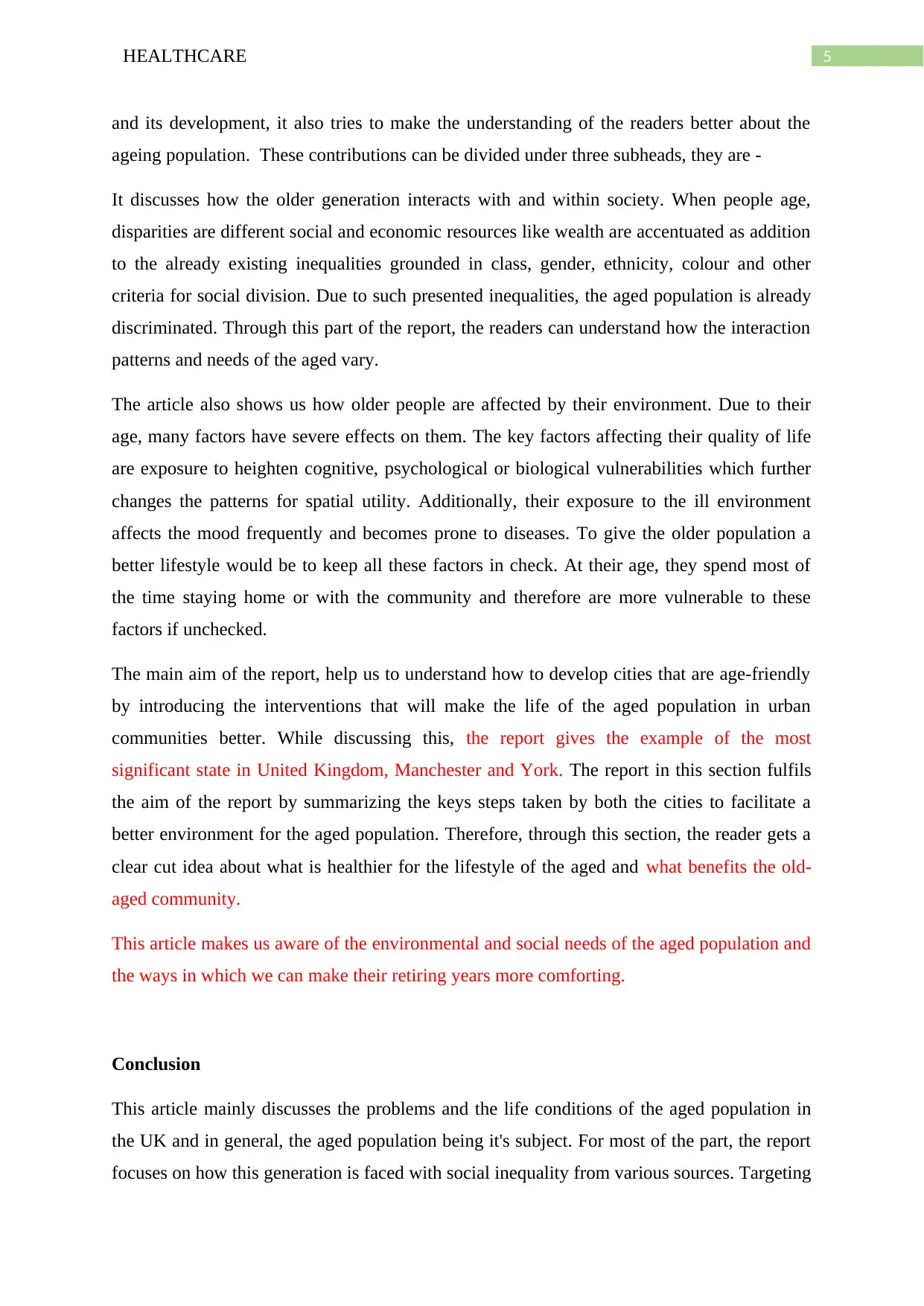
5HEALTHCARE
and its development, it also tries to make the understanding of the readers better about the
ageing population. These contributions can be divided under three subheads, they are -
It discusses how the older generation interacts with and within society. When people age,
disparities are different social and economic resources like wealth are accentuated as addition
to the already existing inequalities grounded in class, gender, ethnicity, colour and other
criteria for social division. Due to such presented inequalities, the aged population is already
discriminated. Through this part of the report, the readers can understand how the interaction
patterns and needs of the aged vary.
The article also shows us how older people are affected by their environment. Due to their
age, many factors have severe effects on them. The key factors affecting their quality of life
are exposure to heighten cognitive, psychological or biological vulnerabilities which further
changes the patterns for spatial utility. Additionally, their exposure to the ill environment
affects the mood frequently and becomes prone to diseases. To give the older population a
better lifestyle would be to keep all these factors in check. At their age, they spend most of
the time staying home or with the community and therefore are more vulnerable to these
factors if unchecked.
The main aim of the report, help us to understand how to develop cities that are age-friendly
by introducing the interventions that will make the life of the aged population in urban
communities better. While discussing this, the report gives the example of the most
significant state in United Kingdom, Manchester and York. The report in this section fulfils
the aim of the report by summarizing the keys steps taken by both the cities to facilitate a
better environment for the aged population. Therefore, through this section, the reader gets a
clear cut idea about what is healthier for the lifestyle of the aged and what benefits the old-
aged community.
This article makes us aware of the environmental and social needs of the aged population and
the ways in which we can make their retiring years more comforting.
Conclusion
This article mainly discusses the problems and the life conditions of the aged population in
the UK and in general, the aged population being it's subject. For most of the part, the report
focuses on how this generation is faced with social inequality from various sources. Targeting
and its development, it also tries to make the understanding of the readers better about the
ageing population. These contributions can be divided under three subheads, they are -
It discusses how the older generation interacts with and within society. When people age,
disparities are different social and economic resources like wealth are accentuated as addition
to the already existing inequalities grounded in class, gender, ethnicity, colour and other
criteria for social division. Due to such presented inequalities, the aged population is already
discriminated. Through this part of the report, the readers can understand how the interaction
patterns and needs of the aged vary.
The article also shows us how older people are affected by their environment. Due to their
age, many factors have severe effects on them. The key factors affecting their quality of life
are exposure to heighten cognitive, psychological or biological vulnerabilities which further
changes the patterns for spatial utility. Additionally, their exposure to the ill environment
affects the mood frequently and becomes prone to diseases. To give the older population a
better lifestyle would be to keep all these factors in check. At their age, they spend most of
the time staying home or with the community and therefore are more vulnerable to these
factors if unchecked.
The main aim of the report, help us to understand how to develop cities that are age-friendly
by introducing the interventions that will make the life of the aged population in urban
communities better. While discussing this, the report gives the example of the most
significant state in United Kingdom, Manchester and York. The report in this section fulfils
the aim of the report by summarizing the keys steps taken by both the cities to facilitate a
better environment for the aged population. Therefore, through this section, the reader gets a
clear cut idea about what is healthier for the lifestyle of the aged and what benefits the old-
aged community.
This article makes us aware of the environmental and social needs of the aged population and
the ways in which we can make their retiring years more comforting.
Conclusion
This article mainly discusses the problems and the life conditions of the aged population in
the UK and in general, the aged population being it's subject. For most of the part, the report
focuses on how this generation is faced with social inequality from various sources. Targeting
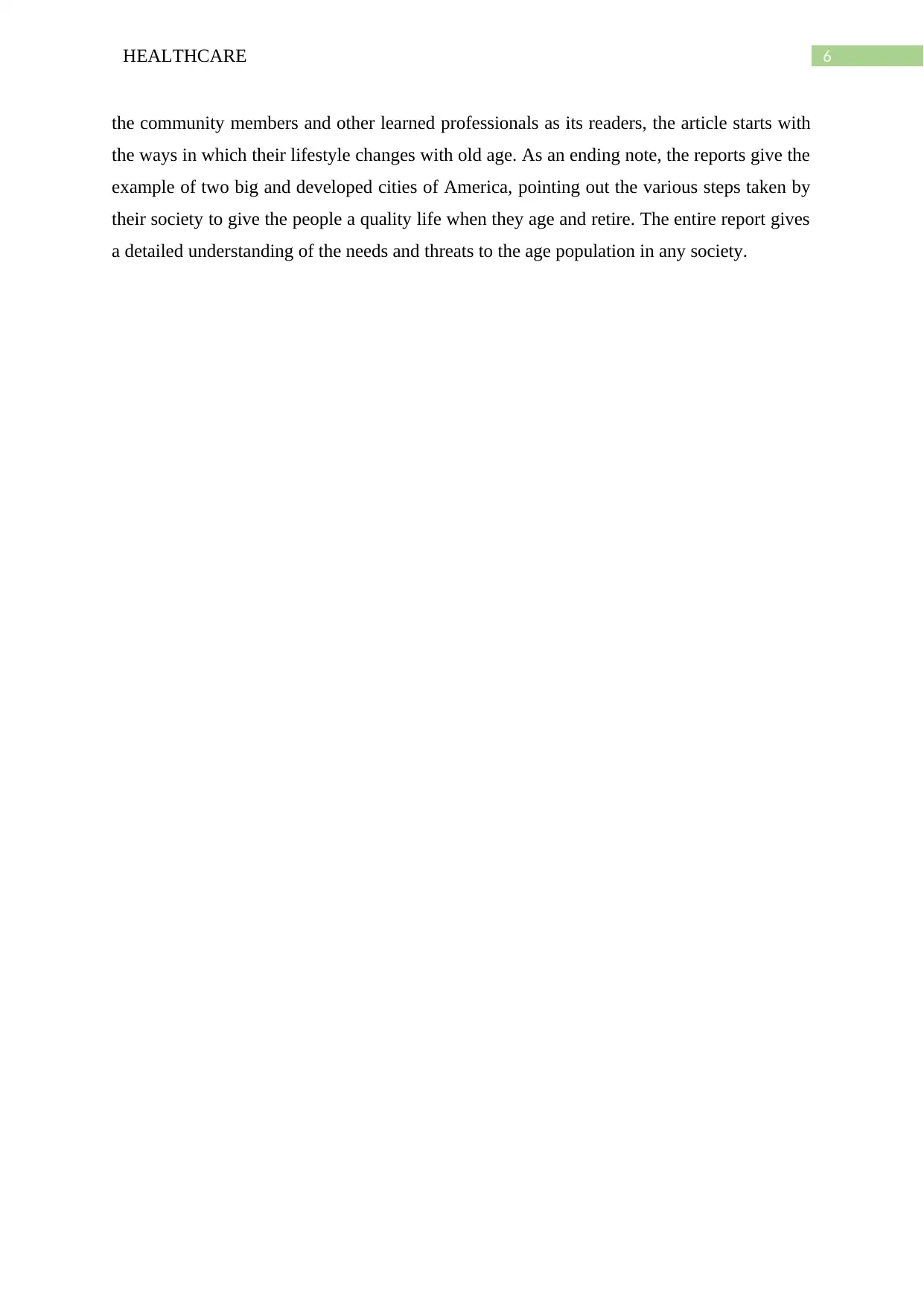
6HEALTHCARE
the community members and other learned professionals as its readers, the article starts with
the ways in which their lifestyle changes with old age. As an ending note, the reports give the
example of two big and developed cities of America, pointing out the various steps taken by
their society to give the people a quality life when they age and retire. The entire report gives
a detailed understanding of the needs and threats to the age population in any society.
the community members and other learned professionals as its readers, the article starts with
the ways in which their lifestyle changes with old age. As an ending note, the reports give the
example of two big and developed cities of America, pointing out the various steps taken by
their society to give the people a quality life when they age and retire. The entire report gives
a detailed understanding of the needs and threats to the age population in any society.
⊘ This is a preview!⊘
Do you want full access?
Subscribe today to unlock all pages.

Trusted by 1+ million students worldwide
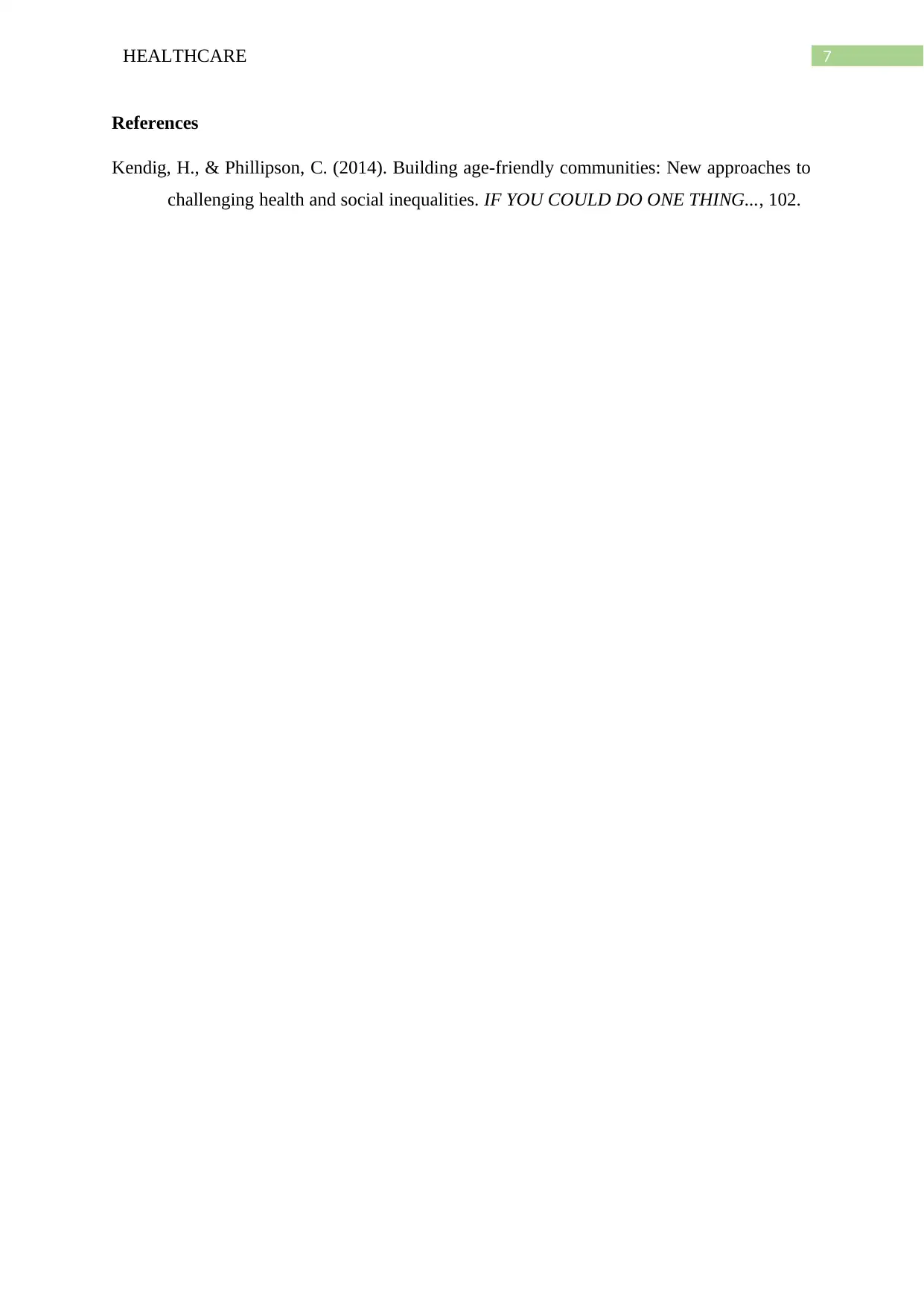
7HEALTHCARE
References
Kendig, H., & Phillipson, C. (2014). Building age-friendly communities: New approaches to
challenging health and social inequalities. IF YOU COULD DO ONE THING..., 102.
References
Kendig, H., & Phillipson, C. (2014). Building age-friendly communities: New approaches to
challenging health and social inequalities. IF YOU COULD DO ONE THING..., 102.
1 out of 7
Related Documents
Your All-in-One AI-Powered Toolkit for Academic Success.
+13062052269
info@desklib.com
Available 24*7 on WhatsApp / Email
![[object Object]](/_next/static/media/star-bottom.7253800d.svg)
Unlock your academic potential
Copyright © 2020–2025 A2Z Services. All Rights Reserved. Developed and managed by ZUCOL.





